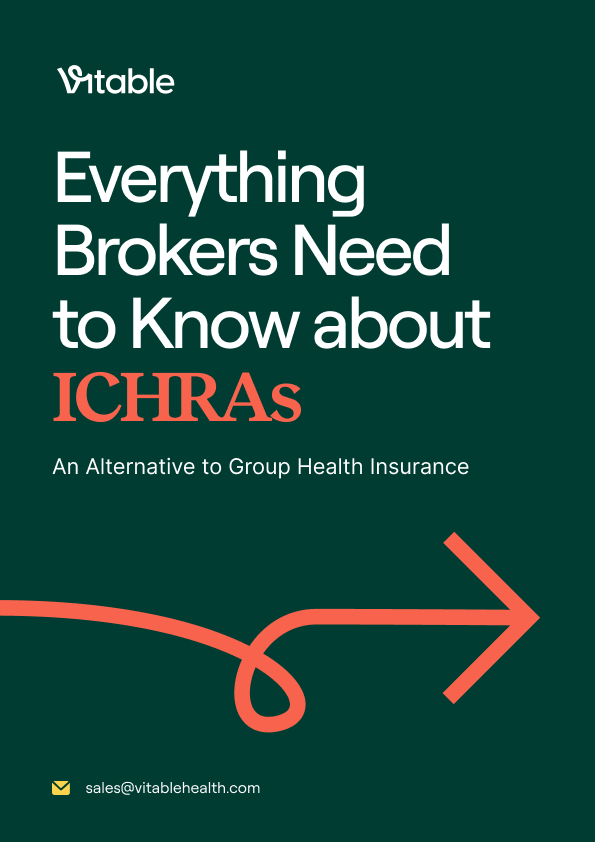Small business health insurance options: Affordable alternatives to costly major medical plans

Buying the correct health insurance policy is essential for small businesses. Doing so will attract talented employees and retain them long-term while keeping your costs manageable so you can continue to grow your business.
But finding an insurance plan that meets your unique requirements is challenging. There are so many small business health insurance options that you may be stuck with "analysis paralysis" and opt not to offer anything or default to signing up with a major medical insurance plan. Below are the common types of small business insurance:
- Fully Insured: A fully insured plan means the business pays a fixed premium to an insurance carrier like UnitedHealth or Blue Cross Blue Shield, which assumes the risk of paying employee medical claims. You benefit from a fixed cost each month but often have less flexibility in what's covered and potentially higher costs than other options.
- Self-Funded: In a self-funded plan, the business pays for employees' medical claims and assumes the financial risk, allocating monthly funds toward these payments. These plans often use a third-party administrator (TPA) for claims processing. Self-funded plans generally have lower costs than fully insured but are at risk of significant or unexpected claims (such as an employee needing surgery).
- Level Funded: A level-funded plan is a hybrid in which the business pays a fixed monthly cost to cover expected claims, stop-loss insurance, and administrative expenses. The company can potentially be refunded excess funds if claims were less than planned, but they are generally more complex to administer.
- Market Plans: Market plans, also known as individual or small group market plans, are health insurance plans available through state or federal exchanges that small businesses can purchase for their employees.

Download 2025 Employer Guide to ICHRA
Vitable’s ICHRA Guide gives employers a clear, step-by-step resource for building smarter, ACA-compliant benefits.
This guide explains how ICHRAs work, who qualifies, and how Vitable simplifies setup, onboarding, reimbursements, and compliance — while giving employees more flexibility, control, and care.

Download Vitable’s 2025 Broker’s Guide to ICHRA
The Broker Guide to ICHRAs is a comprehensive resource that helps brokers understand, sell, and manage Individual Coverage HRAs with confidence.
This guide covers everything from compliance and class design to administration flows, case studies, and how Vitable streamlines quoting, enrollments, and reimbursements for brokers, employers, and employees.
Why small businesses should offer health insurance
Many growing businesses are at least aware of the Affordable Care Act (ACA) but are unaware that it may apply to them. Businesses with at least 50 "full-time equivalents" must offer their employees health insurance or risk heavy penalties. In 2024, the fine for not offering coverage was $2,970/employee.
The meaning of full-time equivalents (FTEs) is commonly misunderstood, which is why 1 in 4 businesses were audited last year for ACA non-compliance. FTEs are calculated by taking the total hours worked per week by any part-time staff, dividing that number by 30, and adding any full-time staff. If that number is over 50, you must offer health insurance as Part of the ACA.
To help bring this to life, imagine Sam's Home Care Agency has 16 full-time employees and 50 part-time workers who average 25 hours/week.
(50 X 25) / 30 = 41.6
41.6 + 16 = 57.6 full-time equivalents
In the eyes of the ACA, Sam's Home Care Agency has 57 FTEs, which is over the threshold of 50 to be considered an applicable large employer (ALE). This means they must offer health insurance or risk being fined a minimum of $80,000 for Part A non-compliance (you can calculate your potential penalties using this free ACA penalty calculator).
In addition to regulatory requirements, companies offering health insurance can improve employee satisfaction and retention, allowing them to attract top talent. Sixty percent of workers say it is the most valuable benefit a company can offer, with more than half stating that health benefits were why they joined their organization in the first place.
The costs of major medical insurance
Many businesses traditionally default to major medical insurance when selecting health coverage for their employees, valuing its established reputation and perceived comprehensive benefits. However, major medical plans often come with higher premiums and limited flexibility in plan design, leading to increased out-of-pocket expenses for employers and employees.
In recent years, there has been a noticeable shift toward alternative insurance models, such as high-deductible health plans (HDHPs) paired with health savings accounts (HSAs) and cost-shifting approaches where employers pass a more significant share of healthcare costs onto employees through higher copays and out-of-pocket maximums. While these models offer lower premiums, they also place a substantial financial burden on employees, potentially increasing the risk of medical debt in the event of unforeseen medical issues.
This financial burden can force employees to delay or forgo necessary care due to high deductibles and prior authorization requirements. As health insurance premiums continue to rise, businesses may see a significant increase in payroll costs, limiting their ability to invest in growth and hiring.
Consequently, some employees may opt out of their employer-sponsored plans, leaving businesses to pay for underutilized benefits and undermining their initial investment. This misalignment between rising insurance costs and employee needs can create significant financial strain for employees and employers.
A cost-effective alternative to major medical
Fortunately, ACA-compliant alternatives to conventional major medical insurance offer significant benefits. Vitable, for instance, provides Minimum Essential Coverage (MEC) and Minimum Value Plans (MVP) that meet ACA requirements and are combined with a delightful virtual direct primary care membership.
This model enhances the value of MEC and MVP plans by offering comprehensive virtual care, mental health support, and free prescriptions with $0 copays and $0 deductibles. This approach eliminates out-of-pocket expenses for employees and includes additional features like billing advocacy and enhanced chronic disease management, which can significantly reduce healthcare costs.
Businesses can lower claims costs by leveraging direct primary care, potentially saving money and improving employee satisfaction through more accessible and affordable care. Employees can leverage their direct primary care membership in lieu of going to urgent care or their primary provider, becoming an excellent cost-containment solution.
This strategy provides a holistic solution that augments traditional insurance plans and effectively addresses immediate and long-term healthcare needs.
If you are a small business owner, we recommend considering alternative health insurance options for your small business. These options improve cost efficiency and employee satisfaction, helping you attract and retain great employees.
Ready to learn more?
Stay ahead with the latest insights on healthcare, benefits, and compliance—straight to your inbox.
Get a quote
Get a personalized health benefits quote tailored to your company’s unique needs.
Vitable helps employers provide better healthcare to their employees and dependents by improving accessibility, cost, and quality.